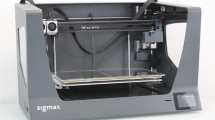Abstract
Material extrusion 3D printing (ME3DP) based on fused deposition modeling (FDM) technology is currently the most commonly used additive manufacturing method. However, ME3DP suffers from a limitation of compatible materials and typically relies upon amorphous thermoplastics, such as acrylonitrile butadiene styrene (ABS). The work presented here demonstrates the development and implementation of binary and ternary polymeric blends for ME3DP. Multiple blends of acrylonitrile butadiene styrene (ABS), styrene ethylene butadiene styrene (SEBS), and ultrahigh molecular weight polyethylene (UHMWPE) were created through a twin screw compounding process to produce novel polymer blends compatible with ME3DP platforms. Mechanical testing and fractography were used to characterize the different physical properties of these new blends. Though the new blends possessed different physical properties, compatibility with ME3DP platforms was maintained. Also, a decrease in surface roughness of a standard test piece was observed for some blends as compared with ABS.







Similar content being viewed by others
References
D-Y. Chang and B-H Huang: Studies on profile error and extruding aperture for the RP parts using the fused deposition modeling process. Int. J. Adv. Manuf. Technol. 53, 1027–1037 (2011).
ASTM Standard F2792-12a: Standard Terminology for Additive Manufacturing Technologies (ASTM International, West Conshohocken, PA, 2012).
D.A. Roberson, D. Espalin, and R.B. Wicker: 3D printer selection: A decision-making evaluation and ranking model. Virtual Phys. Prototyping 8, 201–212 (2013).
S.S. Crump: The fused deposition modeling (FDM). U.S. Patent Nos. 5,121,329 and 5,340,433, 1988.
S. Masood and W. Song: Development of new metal/polymer materials for rapid tooling using fused deposition modelling. Mater. Des. 25, 587–594 (2004).
M. Nikzad, S.H. Masood, and I. Sbarski: Thermo-mechanical properties of a highly filled polymeric composites for fused deposition modeling. Mater. Des. 32, 3448–3456 (2011).
A. Safari and E.K. Akdogan: Rapid prototyping of novel piezoelectric composites. Ferroelectrics 331, 153–179 (2006).
M.L. Shofner, K. Lozano, F.J. Rodríguez-Macías, and E.V. Barrera: Nanofiber-reinforced polymers prepared by fused deposition modeling. J. Appl. Polym. Sci. 89, 3081–3090 (2003).
Ž. Jelčić, N. Vranješ, and V. Rek: Long-range processing correlation and morphological fractality of compatibilized blends of PS/HDPE/SEBS block copolymer. Macromol. Symp. 290, 1–14 (2010).
J.J. Huang, H. Keskkula, and D.R. Paul: Rubber toughening of an amorphous polyamide by functionalized SEBS copolymers: Morphology and Izod impact behavior. Polymer 45, 4203–4215 (2004).
A.J. Oshinski, H. Keskkula, and D.R. Paul: Rubber toughening of polyamides with functionalized block copolymers: 1. Nylon-6. Polymer 33, 268–283 (1992).
V. Tanrattanakul, A. Hiltner, E. Baer, W. G. Perkins, F.L. Massey, and A. Moet, “Toughening PET by blending with a functionalized SEBS block copolymer,” Polymer, 38(9), 2191–2200 (1997).
E. Charles and Carraher, Jr.: Introduction to Polymer Chemistry, 3rd ed. (CRC Press, Boca Raton, Florida, December 4, 2012), p. 298.
K.L.K. Lim, Z.A.M. Ishak, U.S. Ishiaku, A.M.Y. Fuad, A.H. Yusof, T. Czigany, B. Pukanszky, and D.S. Ogunniyi, “High-density polyethylene/ultrahigh-molecular-weight polyethylene blend. I. The processing, thermal, and mechanical properties,” J. Appl. Polym. Sci., vol. 97, no. 1, pp. 413–425, Jul. 2005.
A.K. Gupta and S.N. Purwar: Melt rheological properties of polypropylene/SEBS (styrene–ethylene butylene–styrene block copolymer) blends. J. Appl. Polym. Sci. 29, 1079–1093 (1984).
F. Stricker, Y. Thomann, and R. Mülhaupt: Influence of rubber particle size on mechanical properties of polypropylene–SEBS blends. J. Appl. Polym. Sci. 68, 1891–1901 (1998).
ASTM Standard D638: Standard Test Method for Tensile Properties of Plastics (ASTM International, West Conshohocken, PA2010).
P.M. Pandey, N. Venkata Reddy, and S.G. Dhande: Improvement of surface finish by staircase machining in fused deposition modeling. J. Mater. Process. Technol. 132, 323–331 (2003).
A.R.T. Perez, D.A. Roberson, and R.B. Wicker: Fracture surface analysis of 3D-Printed tensile specimens of novel ABS-based materials. J. Fail. Anal. Prev. 1–11 (2014) doi: https://doi.org/10.1007/s11668-014-9803-9.
L. Engel, H. Klingele, G.W. Ehrenstein, and H. Schaper: An Atlas of Polymer Damage: Surface Examination by Scanning Electron Microscope (Prentice-Hall, Inc., Englewood Cliffs, New Jersey, 1981).
ACKNOWLEDGMENTS
The work presented here was supported by a grant from the Intelligence Community Postdoctoral Research Fellowship Program through funding from the Office of the Director of National Intelligence under Grant No. 2012-12071000005. All statements of fact, opinion, or analysis expressed are those of the author and do not reflect the official positions or views of the Intelligence Community or any other U.S. Government agency. Nothing in the contents should be construed as asserting or implying U.S. Government authentication of information or Intelligence Community endorsement of the author’s views. Additional support came from the National Aeronautics and Space Administration (NASA) under Grant No. 282002-8784. The facilities of the W.M. Keck Center for 3D Innovation and the Department of Metallurgical and Materials Engineering located at The University of Texas at El Paso were used for fabrication, SEM imaging, and material testing throughout this research project.
Author information
Authors and Affiliations
Corresponding author
Rights and permissions
About this article
Cite this article
Rocha, C.R., Perez, A.R.T., Roberson, D.A. et al. Novel ABS-based binary and ternary polymer blends for material extrusion 3D printing. Journal of Materials Research 29, 1859–1866 (2014). https://doi.org/10.1557/jmr.2014.158
Received:
Accepted:
Published:
Issue Date:
DOI: https://doi.org/10.1557/jmr.2014.158




